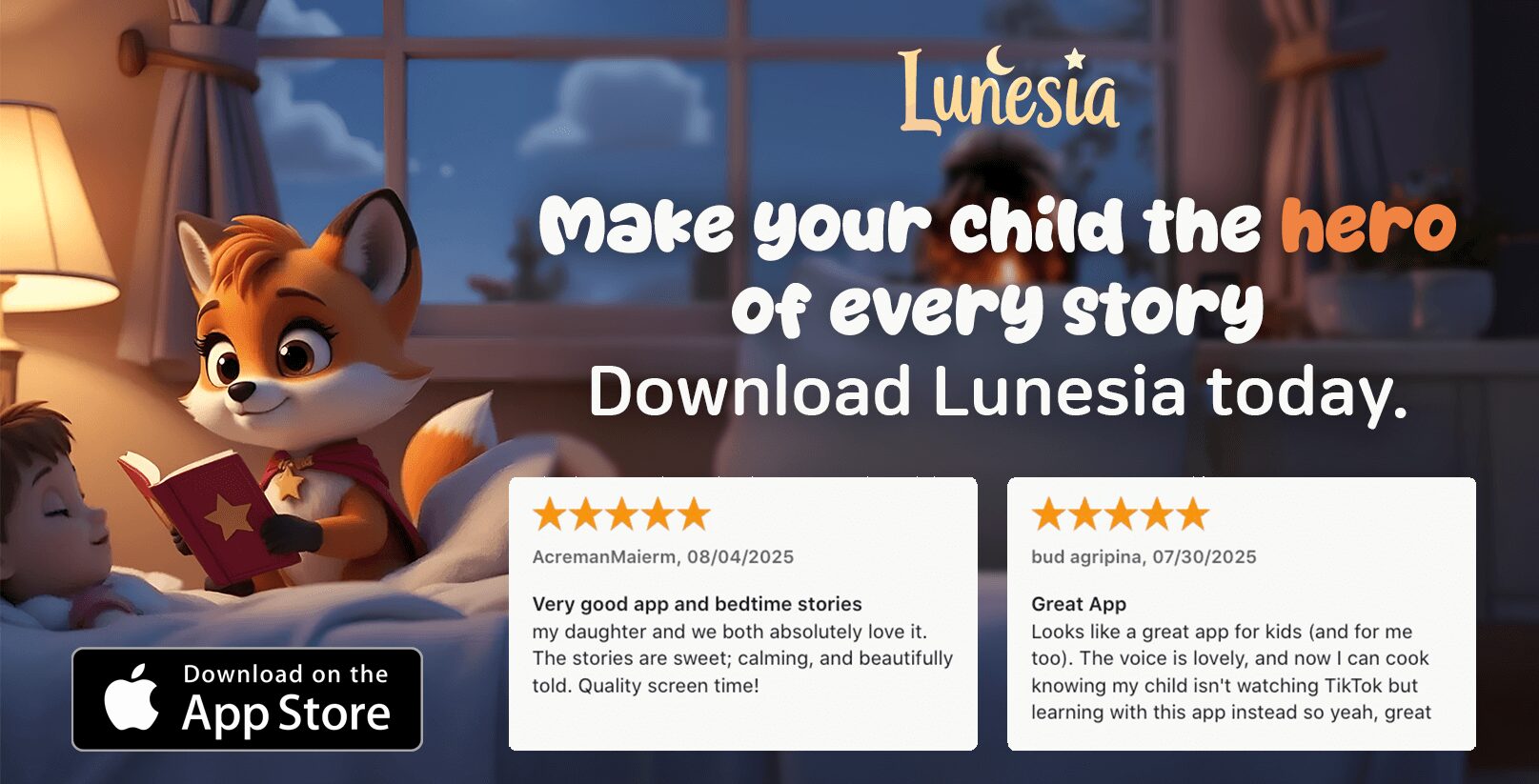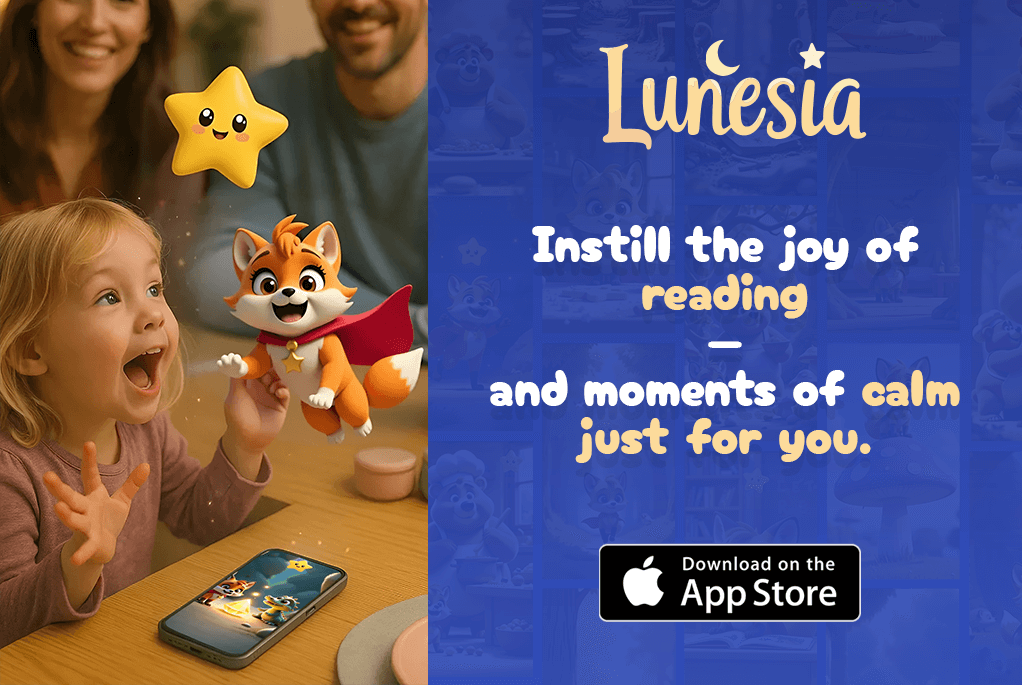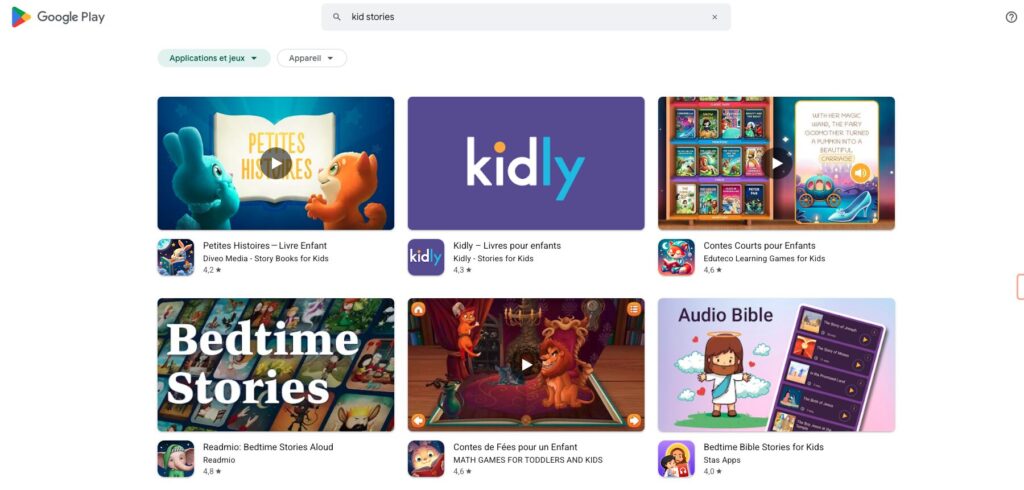I still remember the first time I read a bedtime story to my daughter. Her eyes widened with wonder as the characters came to life, and her imagination soared. That moment wasn’t just about the magic of the tale—it was a foundation for her growth.
Reading a story before bed does more than entertain. It nurtures a child’s emotional, cognitive, and creative development. Research shows that this simple family ritual can activate parts of the brain responsible for language and comprehension.
Whether it’s a classic book or a new adventure, bedtime stories create a bond between parent and child. They foster empathy, problem-solving, and even stress relief. This article will explore how this nightly habit can transform your family routine into a powerful tool for development.
Understanding the Power of Bedtime Stories
Have you ever wondered why a simple tale before bed can work wonders for your child? It’s not just about the words on the page—it’s about the connection, the calm, and the growth that happens in those moments. Science shows that this nightly ritual does more than entertain; it shapes young minds in profound ways.
Scientific Insights into Storytelling
Research reveals that reading a story activates parts of the brain responsible for language and comprehension. When you share a book with your child, you’re helping them build neural pathways that support learning and memory. Studies show that children who are read to regularly develop a 30% larger vocabulary than those who aren’t.
But it’s not just about words. Storytelling also engages the imagination, encouraging your child to visualize and think creatively. This mental exercise is like a workout for the brain, strengthening cognitive skills that will benefit them for years to come.
Emotional and Cognitive Impact
Beyond the science, there’s an emotional magic to storytelling. Sharing a tale creates a bond between you and your child, offering a moment of calm in a busy day. It’s a friend-like experience that eases separation anxiety and builds trust.
For example, reading a classic book like Goodnight Moon can help your child feel secure and ready for sleep. The rhythm of the words and the familiar routine signal to their brain that it’s time to relax. This simple act can lower stress levels and improve sleep quality, making bedtime a peaceful transition for everyone.
Today, more than ever, parents are recognizing the value of this tradition. It’s not just about the story—it’s about the connection, the growth, and the joy it brings to your family.
Boosting Emotional Development Through Stories
Every parent knows the magic of a good book, but its impact goes beyond the pages. Sharing a story with your child can be a powerful tool for emotional growth. It’s not just about the words—it’s about the lessons, the bonding, and the joy it brings to your family.
Building Empathy and Resilience
When you read a story together, you’re teaching your child to see the world through someone else’s eyes. Characters in books often face challenges, make mistakes, and learn valuable lessons. These moments can help your child understand empathy and kindness in real life.
For example, tales like The Giving Tree or Charlotte’s Web show how characters care for others. These stories model compassion and encourage your child to think about how their actions affect those around them.
Resilience is another key lesson. Stories where characters overcome obstacles teach your child that setbacks are part of life. They learn that it’s okay to struggle and that they can find strength to keep going.
As a parent, your role is crucial. You’re not just the narrator—you’re the guide. By discussing the story and asking questions, you help your child process emotions and apply these lessons to their own experiences.
Here’s how storytelling can create a safe space for emotional expression:
- It encourages open conversations about feelings.
- It helps children identify and name their emotions.
- It provides a way to explore complex situations in a safe, fictional setting.
Sharing a book isn’t just a routine—it’s a way to nurture your child’s heart and mind. The emotional bonds you build during these moments will last a lifetime.
Enhancing Cognitive Development with Storytelling
Storytelling isn’t just about entertainment—it’s a powerful tool for cognitive growth. When you share a tale with your child, you’re helping them build skills that will last a lifetime. From language to memory, the benefits are profound and backed by science.
Language and Critical Thinking Skills
Reading a book together exposes your child to new words and sentence structures. This natural absorption of vocabulary and grammar helps them communicate more effectively. For example, classic tales like Charlotte’s Web introduce complex ideas in a simple, engaging way.
The narrative structure of a story also encourages critical thinking. As your child follows the plot, they learn to predict outcomes and analyze characters’ actions. This mental exercise strengthens their problem-solving abilities and prepares them for real-life challenges.
Memory and Concentration Boosters
Storytelling routines, especially at bedtime, help improve memory retention. When your child listens to a tale, they practice recalling details like character names and plot twists. This process enhances their ability to store and retrieve information.
Concentration is another key benefit. Engaging with a story requires focus, which trains your child’s attention span. Over time, this skill translates to better performance in school and other activities.
| Skill | How Storytelling Helps |
|---|---|
| Language | Exposure to new words and grammar |
| Critical Thinking | Analyzing plot and character actions |
| Memory | Recalling details and sequences |
| Concentration | Focusing on the narrative |
In essence, storytelling is like a friend that guides your child through the world of words and ideas. It’s a simple yet effective way to nurture their cognitive development and set them up for success.
Fostering Creativity and Imagination
There’s something truly special about watching a child’s imagination come alive through a story. Whether it’s a classic book like The Ugly Duckling or a modern adventure, storytelling has the power to ignite creativity and open doors to new worlds.
Magical elements in tales trigger creative thinking. When a child encounters a fairy or a mythical creature, their mind starts to wander. They begin to ask questions, imagine possibilities, and create their own narratives. This process is like a mental workout, strengthening their ability to think outside the box.
Every story is an adventure that widens a child’s mental horizons. It transforms an ordinary day into a vivid journey. For example, tales like Peter Pan or Alice in Wonderland take children to places they’ve never been, encouraging them to dream big and explore new ideas.
Here’s how storytelling nurtures creativity:
- It introduces magical and fantastical elements that spark curiosity.
- It encourages children to visualize and create their own versions of the story.
- It builds problem-solving skills by presenting challenges and solutions within the narrative.
As a parent, you can mix classic themes with innovative storytelling styles. Use voices, gestures, and props to make the tale come alive. This not only enhances the experience but also helps your child develop a love for storytelling that lasts a lifetime.
Remember, creativity isn’t just about art—it’s about thinking differently. By sharing a book, you’re giving your child the tools to innovate, adapt, and thrive in an ever-changing world.
Strengthening Family Bonds Through Shared Reading
Creating a nightly reading habit can transform your family’s evenings into moments of connection. It’s not just about the story—it’s about the calm, the closeness, and the joy it brings to your home. Whether it’s a classic book or a new adventure, this simple routine can strengthen your family ties in profound ways.
Establishing a Calming Evening Routine
Consistency is key when it comes to building a calming evening routine. Reading together signals to your family that it’s time to unwind. This shared activity creates a sense of security and comfort, especially for children. Even your dog might settle in, enjoying the peaceful atmosphere.
Here are some strategies to make this routine special:
- Choose a cozy spot in your home where everyone can gather comfortably.
- Pick a book that appeals to all ages, ensuring everyone stays engaged.
- Incorporate soft lighting or calming music to enhance the ambiance.
For example, many families find success with a 15-minute reading session before bed. This short but meaningful time allows everyone to relax and connect. It’s a moment to leave the day’s stress behind and focus on each other.
As a parent, you play a vital role in this routine. Your presence and participation reaffirm your role as a nurturing mentor. This shared experience fosters trust and open communication, making it easier for your child to express their thoughts and feelings.
| Benefit | How It Helps |
|---|---|
| Family Closeness | Creates shared experiences and strengthens bonds |
| Calm Environment | Reduces stress and promotes relaxation |
| Emotional Connection | Encourages open communication and trust |
| Joyful Moments | Brings happiness and togetherness to the family |
Establishing this routine isn’t just about reading—it’s about creating lasting memories. The joy of these moments will stay with your family for years to come. So, grab a book, gather your loved ones, and let the magic of shared reading bring you closer together.
Developing Social Skills Through Story Characters
Characters in stories often become a child’s first friends, guiding them through social challenges. From Pooh Bear’s loyalty to the Three Little Pigs’ teamwork, these figures teach valuable lessons about empathy, cooperation, and understanding.
When you read a book together, you’re introducing your child to relatable role models. For example, Winnie-the-Pooh shows how to be a supportive friend, while the Three Little Pigs demonstrate the importance of planning and teamwork. These characters help children navigate real-life scenarios with confidence.
Both boy and girl characters offer diverse perspectives. Whether it’s a brave hero or a clever heroine, these figures teach kids to see the world through different eyes. This understanding fosters empathy and helps them build stronger relationships with peers.
Here’s how story characters enhance social skills:
- They model kindness, resilience, and problem-solving.
- They introduce the concept of friendship and cooperation.
- They provide a safe space to discuss emotions and actions.
As a parent, you can deepen these lessons by discussing character motives. Ask questions like, “Why do you think Pooh helped his friend?” or “What would you do in the pigs’ situation?” These conversations build empathy and understanding, preparing your child for smoother peer interactions.
In essence, every story is a lesson in social growth. By sharing these tales, you’re giving your child the tools to navigate friendships, resolve conflicts, and thrive in their social world.
Science Behind Storytelling: How Stories Impact the Brain
The human brain is wired to respond to stories in ways that go beyond simple entertainment. When you share a book with your child, you’re not just telling a tale—you’re shaping their brain. Research shows that storytelling activates multiple regions of the brain, fostering growth in language, memory, and emotional regulation.
Neurological Benefits Explored
One of the most fascinating aspects of storytelling is its ability to enhance brain plasticity. When a child engages with a story, their brain forms new neural connections. This process strengthens cognitive skills like problem-solving and critical thinking. For example, the calming imagery of a tree in a story can help reduce stress and improve focus.
Language processing is another key benefit. As your child listens to a book, their brain’s language centers light up. This exposure to new words and sentence structures boosts vocabulary and comprehension. Studies show that children who are read to regularly develop a 30% larger vocabulary than those who aren’t.
Storytelling also plays a role in emotional regulation. The power of a well-told tale can evoke empathy and understanding. For instance, stories that explore kindness or resilience help children process their own emotions. This emotional engagement creates measurable changes in young brains, supporting overall learning and creativity.
Here’s how storytelling impacts the brain:
- Enhances brain plasticity by forming new neural connections.
- Stimulates language centers, improving vocabulary and comprehension.
- Regulates emotions through narrative engagement and empathy.
In essence, the magic of storytelling lies in its ability to transform the brain. By sharing a book, you’re giving your child the tools to grow, learn, and thrive in a complex world.
Choosing the Right Bedtime Story
Selecting the perfect story for your child can feel like finding a hidden treasure. It’s not just about the words on the page—it’s about sparking curiosity, fostering growth, and creating lasting memories. The right book can turn an ordinary day into an extraordinary adventure.
Age-Appropriate and Thematic Selection
When choosing a story, consider your child’s age and developmental stage. Younger children thrive on simple, repetitive tales with vibrant illustrations. Older kids enjoy more complex plots and characters that reflect their growing understanding of the world.
Aligning themes with school readiness and home values is also key. For example, books about kindness or teamwork can reinforce lessons learned during the day. Classics like The Very Hungry Caterpillar introduce early learning concepts, while modern tales like Ada Twist, Scientist inspire curiosity and problem-solving.
Adapting Stories for Individual Interests
Every child is unique, and their interests should guide your selection. If your little one loves animals, explore tales like Brown Bear, Brown Bear. For budding adventurers, books like Where the Wild Things Are can ignite their imagination.
Parents can also adapt well-known tales to suit individual preferences. Add sound effects, change character names, or create alternate endings to make the story more engaging. This personal touch turns reading into a shared adventure.
| Age Group | Recommended Themes | Examples |
|---|---|---|
| 0-3 years | Simple, repetitive stories | Goodnight Moon, The Very Hungry Caterpillar |
| 4-7 years | Adventure and problem-solving | Where the Wild Things Are, Ada Twist, Scientist |
| 8+ years | Complex plots and diverse themes | Harry Potter, Wonder |
By thoughtfully selecting a book, you’re not just reading—you’re creating a learning experience. Whether it’s a classic or a modern tale, the right story can inspire, educate, and bring your family closer together.
Integrating Storytelling into Daily Routines
Turning storytelling into a daily habit can transform ordinary moments into extraordinary learning opportunities. Whether it’s a quick story during breakfast or a longer adventure before bed, these moments enrich your child’s day and strengthen your bond.

- Start small: Begin with a 5-minute story during a calm moment, like after lunch or before nap time.
- Use everyday moments: Turn a car ride or a walk into a mini storytelling session. Narrate what you see or create a tale together.
- Create a cozy space: Designate a corner in your home for reading. Add cushions, blankets, and a basket of books to make it inviting.
Storytelling isn’t just about entertainment—it’s a way to teach and connect. For example, reading a book about sharing can spark a conversation about kindness. These small lessons add up, shaping your child’s character and understanding of the world.
Establishing a routine also helps transition from a busy day to a calm evening. A consistent bedtime story signals to your child that it’s time to unwind. This ritual creates a sense of security and prepares them for a restful night.
| Time of Day | Storytelling Activity | Benefits |
|---|---|---|
| Morning | Quick tale during breakfast | Starts the day with creativity |
| Afternoon | Interactive story during playtime | Enhances problem-solving skills |
| Evening | Calming story before bed | Promotes relaxation and bonding |
As you weave storytelling into your daily life, you’ll notice its impact. Your child’s vocabulary will grow, their imagination will flourish, and your home will be filled with the joy of shared adventures. It’s a simple yet powerful way to nurture their development and create lasting memories.
Exploring Popular Bedtime Stories and Tales
From fairy tales to epic adventures, stories have shaped childhoods for generations. These tales transport children to magical worlds, teaching lessons and sparking imagination. Whether it’s a classic or a modern adventure, each story offers a unique window into a different world.
Classic Favorites and Timeless Tales
Classic stories like Cinderella and Rapunzel have stood the test of time. Their universal themes of love, courage, and resilience resonate with children and adults alike. These tales often feature simple yet powerful messages that teach valuable life lessons.
For example, The Lion King explores themes of responsibility and family. Its rich storytelling and memorable characters make it a favorite across generations. Such stories create a sense of nostalgia while remaining relevant today.
Modern Adventures for Today’s Child
Modern tales like Ada Twist, Scientist and Where the Wild Things Are cater to today’s young audience. These stories often blend creativity with real-world issues, encouraging children to think critically and dream big.
For instance, Ada Twist, Scientist inspires curiosity and problem-solving. Its engaging narrative and relatable characters make it a hit with kids who love science and exploration. Modern stories often use vibrant illustrations and interactive elements to captivate young readers.
| Classic Tales | Modern Adventures |
|---|---|
| Cinderella | Ada Twist, Scientist |
| Rapunzel | Where the Wild Things Are |
| The Lion King | The Very Hungry Caterpillar |
Both classic and modern stories offer unique benefits. Classic tales provide timeless lessons, while modern adventures reflect contemporary values. Parents can mix and match these stories to create a rich and diverse reading experience for their children.
Encourage your child to explore different worlds through these tales. Whether it’s a fairy tale or a space adventure, each story has the power to inspire, educate, and entertain. The magic of storytelling lies in its ability to connect generations and spark endless possibilities.
Bedtime Story Variations: Audio, Picture Books, and More
Exploring different formats of storytelling can open up new worlds for your child. Whether it’s a classic tale or a modern adventure, the way you share a story can make all the difference. From audio versions to interactive digital options, each format offers unique benefits that cater to diverse family needs.
Benefits of Audio Versions
Audio stories are a fantastic way to engage auditory learners. Listening to a narrated tale can help children focus on the rhythm and tone of the voice, enhancing their listening skills. Studies show that 60% of children aged 3-7 find it easier to fall asleep after listening to a calming audiobook compared to traditional reading.
For busy families, audio versions are a convenient option. They allow parents to multitask while still providing a meaningful storytelling experience. Plus, many audiobooks include sound effects and music, making the adventure even more immersive.
Interactive Books and Digital Options
Interactive digital books bring a modern twist to storytelling. These options often include animations, touch-sensitive features, and even games that keep children engaged. For example, apps like ReadTheTale.com offer interactive stories that encourage kids to participate in the narrative, fostering creativity and problem-solving skills.
Digital formats are also highly accessible. Whether on a tablet or smartphone, these tales can be enjoyed anywhere, making them perfect for on-the-go families. Despite the digital medium, the essence of a good story remains intact, ensuring children still experience the magic of imaginative storytelling.
Traditional picture books hold their own charm, but combining them with audio and digital options can create a richer experience. Each format has its strengths, and having multiple choices allows families to adapt to different moods and situations. Whether it’s a cozy bedtime read or an interactive adventure, the core benefits of storytelling—imagination, connection, and learning—are always present.
Incorporating Diverse Story Themes
Exploring different themes in storytelling can open doors to new perspectives for your child. From magical adventures to real-life lessons, diverse themes enrich their imagination and understanding of the world. By introducing a variety of stories, you’re not just entertaining—you’re preparing them for life’s challenges.
Fantasy, Adventure, and Real-Life Lessons
Fantasy and adventure tales, like those featuring a brave boy or a clever girl, spark creativity. These stories transport children to magical realms where they can dream big. For example, a fairy tale about a talking cat can teach problem-solving and resilience in a fun, imaginative way.
Realistic stories, on the other hand, offer valuable life lessons. They help children navigate everyday situations, like making friends or overcoming fears. By mixing genres, you create a balanced reading experience that’s both educational and enjoyable.
Here’s how diverse themes benefit your child:
- They nurture imagination and creativity.
- They teach empathy and problem-solving.
- They prepare children for real-world challenges.
For instance, a story about a girl who saves her village can inspire courage, while a tale about a boy learning to share can model kindness. These themes broaden your child’s perspective and help them grow into well-rounded individuals.
By choosing stories with diverse characters and settings, you’re giving your child the tools to thrive in a complex world. Whether it’s a magical adventure or a heartfelt lesson, every story has the power to teach, inspire, and connect.
Tips for Parents to Enhance Bedtime Story Sessions
Creating a calming and engaging space for reading can make storytelling sessions more memorable and effective. As a parent, I’ve found that a little preparation goes a long way in turning these moments into cherished family traditions. Here are some practical tips to help you set the stage for a distraction-free and enriching experience.
Creating the Perfect Environment
A cozy reading nook can transform storytelling into a magical experience. Start by choosing a quiet corner in your home where you and your child can relax. Soft lighting, like a dim lamp or fairy lights, can create a soothing atmosphere. Adding a plush rug or cushions makes the space inviting and comfortable.
Consider incorporating nature-inspired décor, such as a tree or forest-themed wall art, to add a calming visual cue. Studies show that children are 85% more focused in a comfortable setting. This small effort can make a big difference in how engaged your child feels during the session.
Active Listening and Engagement Techniques
Active listening is key to keeping your child engaged. Use expressive voices for different characters and pause to ask questions like, “What do you think will happen next?” This not only keeps them interested but also encourages critical thinking.
Here are some techniques to enhance engagement:
- Use gestures and facial expressions to bring the story to life.
- Encourage your child to predict the plot or describe the characters.
- Relate the story to their daily experiences, such as something that happened at school or today.
Building a predictable routine also helps. Whether it’s a 10-minute session before bed or a quick tale after dinner, consistency signals to your child that it’s time to unwind. This routine reinforces the magic of storytelling and creates a sense of security.
| Tip | Benefit |
|---|---|
| Soft Lighting | Creates a calming atmosphere |
| Nature-Inspired Décor | Adds a soothing visual element |
| Expressive Voices | Keeps the child engaged |
| Predictable Routine | Builds a sense of security |
By following these tips, you’re not just reading a story—you’re creating a bonding experience that nurtures your child’s imagination and emotional growth. A well-prepared environment and active engagement techniques can turn ordinary moments into extraordinary memories.
Real Stories: Testimonials from American Families
Real-life experiences from families across the U.S. show how storytelling transforms everyday moments into cherished memories. These heartfelt accounts highlight the profound impact of shared tales on family routines and emotional connections.
One parent shared,
“Our nightly reading sessions with our dog curled up beside us have become the highlight of our day. It’s a calming ritual that brings our family closer together.”
Pets often play a central role, adding warmth and comfort to these moments.
Another testimonial from a mother of two emphasized the benefits for her children.
“My girl loves stories about brave heroines, while my boy prefers adventurous tales. These stories not only entertain but also teach them valuable life lessons.”
This balance ensures both children feel included and inspired.
Families also find that storytelling helps children navigate challenges. A father recounted,
“When our cat passed away, we found comfort in a story about loss and healing. It helped our kids process their emotions in a way we couldn’t have imagined.”
These real-life examples validate the emotional and educational benefits of storytelling.
Here’s how these moments make a difference:
- They create a sense of security and routine.
- They foster empathy and understanding through relatable characters.
- They strengthen family bonds and encourage open communication.
We encourage parents to share their own experiences. Whether it’s a funny anecdote or a touching moment, your story can inspire others to embrace this meaningful tradition. Together, we can build a community that celebrates the power of storytelling in shaping young minds and hearts.
The Role of “bedtime stories” in School Success
The simple act of reading before sleep can shape a child’s academic journey in surprising ways. Sharing a bedtime story isn’t just a calming ritual—it’s a powerful tool for building literacy skills, confidence, and social competence. Research shows that children who engage in regular story time often perform better in school, thanks to the cognitive and emotional benefits of this nightly habit.
Literacy skills developed through storytelling directly translate to classroom success. When a child listens to a story, they absorb new vocabulary, sentence structures, and narrative patterns. This exposure helps them read and write more effectively. For example, a tale about a clever girl or a brave boy can introduce complex ideas in a simple, engaging way.

Regular story time also builds confidence and critical thinking. As children follow plots and analyze characters, they learn to predict outcomes and solve problems. This mental exercise strengthens their ability to tackle academic challenges. A calm bedtime routine, like reading under a cozy blanket, signals to their brain that it’s time to relax and focus, preparing them for a productive day ahead.
Character lessons from stories subtly contribute to social competence. Tales featuring a loyal cat or a kind girl teach empathy and cooperation. These lessons help children navigate friendships and resolve conflicts, both in and out of the classroom. Just as a vibrant forest thrives with diversity, a child’s inner world flourishes with varied stories and experiences.
Parents can view storytelling as an investment in their child’s academic journey. By creating a cozy environment and choosing engaging tales, you’re not just reading—you’re nurturing their growth. Whether it’s a classic adventure or a modern tale, every story has the power to inspire, educate, and prepare your child for success in school and beyond.
Conclusion
As the snow falls outside, there’s nothing quite like the warmth of a shared tale to bring a family closer. A bedtime story isn’t just a routine—it’s a blend of science, art, and heartfelt tradition. It nurtures emotional growth, sharpens cognitive skills, and strengthens social bonds, all while creating memories that last a lifetime.
From the magical touch of a fairy tale to the comforting presence of a purring cat, these moments open doors to a child’s imagination. They teach empathy, resilience, and the joy of discovery. Every story is a step toward a brighter world, where children learn to navigate challenges with confidence.
Take the tips shared here and make storytelling a daily ritual. Whether it’s a snowy evening or a quiet afternoon, let the power of a good tale transform your family’s routine. Thank you for embracing this journey—each story you share builds a foundation of love, learning, and endless possibilities.
FAQ
How do bedtime stories benefit my child’s development?
Reading before sleep helps improve language skills, boosts creativity, and strengthens emotional resilience. It also fosters a love for learning and enhances parent-child bonding.
What types of stories are best for young children?
Choose age-appropriate tales with simple language, engaging characters, and positive messages. Classic fairy tales, modern adventures, and stories with moral lessons are great options.
Can storytelling help my child’s social skills?
Absolutely! Stories introduce children to diverse characters and situations, teaching empathy, problem-solving, and how to navigate social interactions.
How can I make bedtime reading more interactive?
Use different voices for characters, ask questions about the story, and encourage your child to predict what happens next. This keeps them engaged and enhances comprehension.
Are audio stories as effective as reading aloud?
Audio versions are a great alternative, especially for busy parents. They still improve listening skills and imagination, though reading together strengthens family bonds.
How do I choose stories that match my child’s interests?
Pay attention to their favorite themes, like animals, magic, or adventure. Tailor your selection to their hobbies and encourage them to pick stories they love.
Can storytelling help with my child’s school performance?
Yes! Regular storytelling enhances vocabulary, critical thinking, and concentration, which are essential for academic success.
What if my child doesn’t enjoy bedtime reading?
Try different formats like picture books, interactive apps, or themed stories. Make it fun and relaxing, and let them choose what they want to explore.
How long should a bedtime story session last?
Aim for 10-20 minutes, depending on your child’s age and attention span. The goal is to create a calming routine without overwhelming them.
Can I use storytelling to address my child’s fears?
Yes! Stories with relatable characters overcoming challenges can help children process emotions and feel more confident in facing their own fears.




